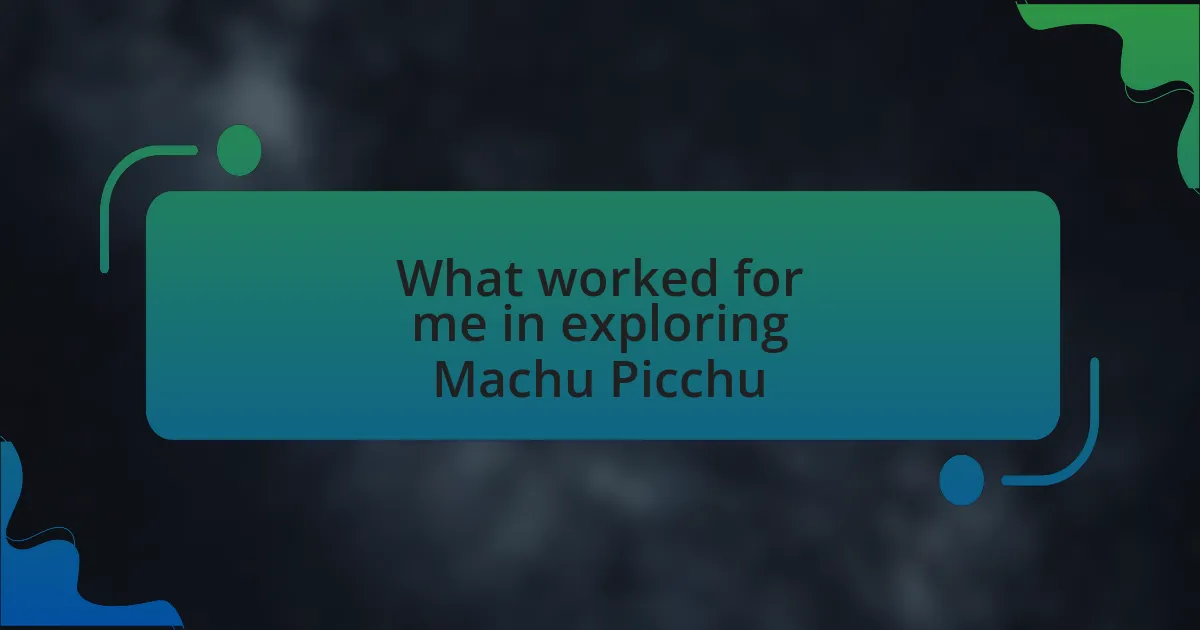Key takeaways:
- Travel blogging enhances personal storytelling, fostering connections with readers and fellow travelers.
- Amsterdam’s museums offer diverse cultural experiences, requiring thoughtful planning to appreciate fully.
- Documenting experiences, both through writing and photography, deepens personal connections to art and history.
- Engaging with art and taking breaks leads to more enriching visits, emphasizing the importance of pacing and reflection.
Author: Evelyn Hartley
Bio: Evelyn Hartley is a bestselling author known for her compelling historical novels that delve into the complexities of human relationships. With a background in literature and a passion for storytelling, she crafts richly detailed narratives that transport readers to different eras. Her award-winning debut novel, “Whispers of the Past,” was praised for its vivid characters and intricate plots. When she’s not writing, Evelyn enjoys exploring antique shops and researching the fascinating stories behind forgotten artifacts. She resides in a charming cottage in Vermont, where she draws inspiration from the beauty of nature and the stories it holds.
Introduction to travel blogging
Travel blogging is more than just sharing pictures and itineraries; it’s about weaving personal experiences into the tapestry of exploration. I remember my first journey abroad, fumbling to capture the essence of a city that felt alive with history. As you write about your travels, consider this: how can your unique perspective guide others on their own adventures?
When I think back to my explorations, the moments that stand out aren’t always the grand events, but the small interactions—like chatting with a local over a cup of coffee. These snippets of connection not only enrich your storytelling but also resonate with readers. How do you think these shared experiences deepen our understanding of a place?
Every travel blog has the potential to inspire wanderlust, but infusing your personality makes it truly memorable. Have you ever felt like you could reach out and touch the soul of a city through the words on a page? I’ve had that feeling, and it’s that connection that transforms ordinary travel narratives into extraordinary journeys for both the writer and the reader.
Benefits of travel blogging
Travel blogging allows for a profound connection with fellow wanderers. I vividly recall receiving an email from a reader who followed my journey through the museums of Amsterdam. Their excitement about visiting the Van Gogh Museum, inspired by my stories, reminded me of the impact my words can have.
Through writing about my travels, I’ve not only chronicled my adventures but also honed my storytelling skills. Every time I sit down to reflect on a trip, it feels like a deep dive into my memories, helping me capture the nuances I might otherwise overlook. Do you ever find that your writing reveals truths about your experiences that you hadn’t fully recognized before?
Moreover, sharing my experiences has helped me build a community of like-minded explorers. I once met a fellow travel blogger at a café in Amsterdam, sparked by our mutual love for discovering hidden gems. Isn’t it fascinating how the stories we tell can lead us to unexpected friendships?
Overview of museums in Amsterdam
Amsterdam boasts a rich tapestry of museums that reflect its vibrant cultural heritage. From the famed Van Gogh Museum, where I first encountered the emotional intensity of his artwork, to the historical Anne Frank House, each space tells a captivating story. It’s often struck me how stepping into these museums feels like time travel, immersing me in the art and narratives of the past.
I remember standing before Rembrandt’s “Night Watch” in the Rijksmuseum, completely awestruck. The way the light dances across the canvas is mesmerizing, revealing the master’s genius. This encounter reaffirms my belief that museums in Amsterdam are not merely collections of artifacts; they are gateways to understanding the lives and emotions of those who came before us. Have you ever felt that exhilarating rush when art resonates deeply with your own life experiences?
The diversity of Amsterdam’s museums truly caters to varied interests, from contemporary art at the Stedelijk Museum to the whimsical exhibits of the Moco Museum. Each visit has enriched my understanding of different artistic movements, and it often surprises me how much I learn with every new exhibit. If you’re considering a museum-hopping adventure, trust me: you’ll leave with not just souvenirs, but also new perspectives and inspiration.
Planning your museum visits
Planning your museum visits requires careful consideration of timing and ticketing. I discovered the hard way that peak hours can lead to long lines and crowded galleries, significantly detracting from the experience. By opting for early morning or late afternoon visits, I found I could truly appreciate the works without the distraction of a bustling crowd—have you ever tried standing in front of a masterpiece only to be jostled by fellow visitors?
Another essential aspect of planning is to prioritize the museums you want to visit based on your interests. When I crafted my itinerary, I made sure to include a mix of art, history, and niche exhibits. This balance allowed me to explore different facets of Amsterdam’s cultural scene and left room for those spontaneous discoveries that often turn into cherished memories—like stumbling upon a hidden gem of a museum that I hadn’t initially considered.
Finally, it’s wise to check if the museums offer combo tickets or free admission on certain days. This tip saved me both time and money during my travels. While wandering through the streets of Amsterdam, I came across signage that instructed me on special promotions, making it easier to stretch my budget and enjoy more exhibits. Have you ever felt the thrill of snagging a good deal while traveling? It can transform your entire experience!
Tips for visiting museums effectively
When visiting museums, take the time to engage with the exhibits. I remember standing in front of a painting at the Van Gogh Museum, feeling the brush strokes come alive as I absorbed the details. It made me realize that reading the descriptions and taking a moment to reflect can transform a quick visit into an enriching experience—have you ever had a moment where you stood mesmerized, losing track of time?
Another tip I learned is to embrace guided tours. On my visit to the Rijksmuseum, joining a guided tour opened my eyes to stories behind the artwork that I would have otherwise missed. The guide’s passion was infectious; it made the history come alive. Wouldn’t you agree that sometimes, having a knowledgeable voice sharing insights can deepen your appreciation for art?
Don’t forget to take breaks while exploring. I learned the hard way that too much time on my feet could lead to fatigue. At the Stedelijk Museum, I made it a point to step away for a coffee break, allowing myself to recharge. That pause turned out to be a perfect moment to reflect on what I’d seen. How do you ensure that you stay energized during a full day of museum hopping?
Documenting your museum experiences
As I wandered through the exhibits, I found that jotting down my thoughts and feelings enhanced my experience immensely. After visiting the Anne Frank House, I took a moment on the stairs outside to reflect on the profound impact of her story on my life. Writing my feelings right there helped solidify those emotions; have you ever captured an experience so vividly by writing it down on the spot?
Photography also plays a key role in documenting your museum journey, but I learned the importance of balance. While snapping pictures at the Rembrandt House, I made a conscious effort to put my camera down and actually absorb the surroundings. I still remember the thrill of seeing “The Night Watch” in person, and the photos I took served as reminders, but the real memory lies in the moments I experienced without a lens. How do you capture memories without losing the moment itself?
Keeping a dedicated travel journal has become my go-to method for documenting my museum experiences. Each time I visit a new place, I write about the art, the emotions it evoked, and the personal resonance it had with my journey. For example, after exploring the Van Loon Museum, I penned a reflection about how art can mirror life’s tapestry. It’s fascinating to look back and see how each visit has shaped my perspective; do you think recording these experiences deepens our connection to the places we visit?
Lessons learned from my journey
One of the biggest lessons I learned during my museum journey was the importance of pacing myself. In the beginning, I tried to cram too many museums into one day, which left me feeling overwhelmed and fatigued. Visiting the Rijksmuseum, I decided to take a break in the beautiful gardens to enjoy the surroundings. That moment reminded me that it’s okay to slow down and truly savor each experience; have you ever found that resting can be just as rewarding as exploring?
Emotional connections also emerged as a significant part of my museum visits. At the Van Gogh Museum, standing in front of “Starry Night,” I felt a rush of emotions, almost as if the painting was speaking to my own struggles and dreams. Sharing these feelings on social media opened up discussions with friends about how art can resonate on a deeply personal level. Have you ever encountered a piece of art that mirrored your own life experiences?
Lastly, interacting with fellow visitors and staff enriched my journey immensely. I once met a couple who shared their favorite hidden gems within the Hermitage, leading me to discover exhibits I might have overlooked. It’s amazing how a simple conversation can broaden your perspective. Isn’t it fascinating how other people’s stories can enhance your own adventures?




